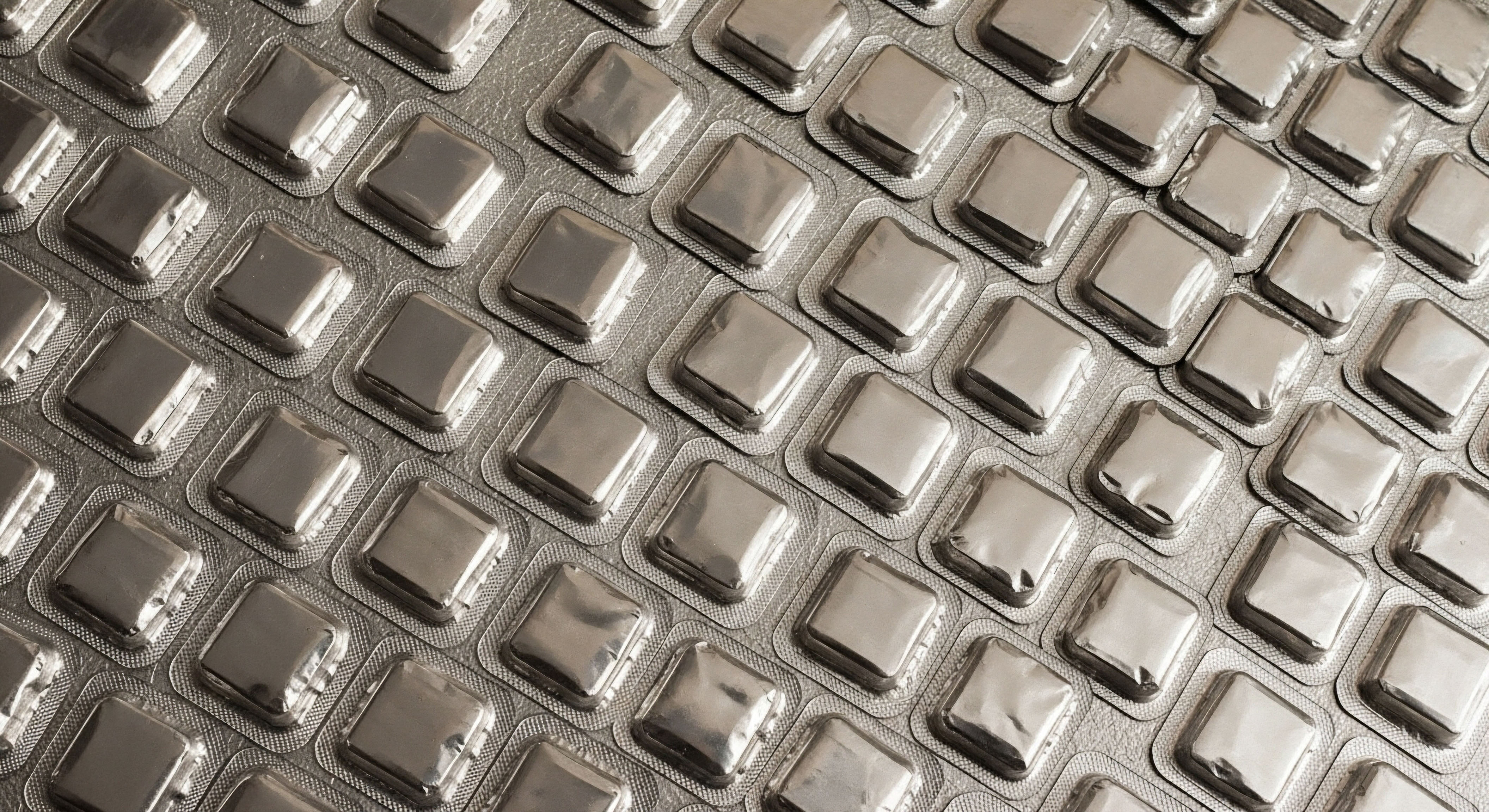

Fundamentals
You feel the firmness beneath your skin, a density around your midsection that remains stubbornly in place despite your dedicated efforts with diet and exercise. This experience is a common and deeply personal challenge. The fat you can pinch is subcutaneous fat.
The fat causing this deep, internal pressure is visceral adipose tissue (VAT), and it functions very differently. It is an active organ, one that resides deep within your abdominal cavity, surrounding your vital organs like the liver, pancreas, and intestines. Its presence is linked to a host of metabolic disturbances because it secretes inflammatory signals and hormones that disrupt your body’s systemic balance.
Achieving a reduction in this specific type of fat is a primary goal for long-term health. The conversation about how to accomplish this often presents two paths ∞ lifestyle interventions and hormonal protocols. Lifestyle, which encompasses nutrition and physical activity, is the absolute foundation of metabolic health.
A recent meta-analysis published in the British Journal of Sports Medicine confirmed that both caloric restriction and exercise are effective at reducing visceral fat. The research revealed a particularly compelling detail about physical activity ∞ it demonstrates a dose-response relationship with visceral fat. This means that increasing the amount of energy you expend through exercise directly corresponds to a greater reduction in VAT. Your work in the gym and your conscious food choices are powerful, scientifically-validated tools.
Lifestyle interventions form the essential groundwork for reducing visceral fat, with exercise showing a direct dose-dependent effect on its reduction.

Understanding the Body’s Internal Command Center
Your body operates under the direction of an intricate communication network known as the endocrine system. This system uses hormones as chemical messengers to regulate everything from your heart rate and mood to your metabolism and how you store energy. When this system is balanced, your body responds predictably to your lifestyle efforts.
You eat well and exercise, and you see the results you expect. However, factors like aging, chronic stress, and environmental exposures can disrupt this delicate hormonal symphony. When key hormones like testosterone, estrogen, or growth hormone decline or become imbalanced, the body’s instructions for fat storage can be fundamentally altered. The system begins to favor depositing energy as visceral fat, making your lifestyle efforts feel like an uphill battle.
This is where the distinction between the two approaches becomes clear. Lifestyle interventions are your direct actions upon your body. Hormonal protocols are a method of recalibrating the internal command center that dictates how your body responds to those actions. One works from the outside in; the other works from the inside out. Both can lead to the same destination, but the efficiency and feasibility of the journey depend entirely on the state of your internal biological environment.

A Tale of Two Fats
To truly grasp the challenge, it is important to understand the distinct nature of the fat you are targeting. Subcutaneous fat and visceral fat are located in different areas and have profoundly different biological effects.
| Characteristic | Subcutaneous Fat | Visceral Fat (VAT) |
|---|---|---|
| Location | Located just beneath the skin; the fat you can pinch. | Located deep within the abdominal cavity, surrounding organs. |
| Metabolic Activity | Less metabolically active. Functions primarily as an energy reserve and for insulation. | Highly metabolically active. Secretes hormones and inflammatory proteins (cytokines). |
| Health Impact | Considered less harmful in moderate amounts. | Strongly linked to insulin resistance, type 2 diabetes, and cardiovascular disease. |
| Response to Interventions | Responds well to general caloric deficit and exercise. | Highly responsive to exercise, but its accumulation is heavily influenced by hormonal status. |


Intermediate
The question of whether lifestyle alone can match the visceral fat reduction of hormonal protocols moves into sharper focus when we examine the body’s master regulatory systems. Your metabolic health is largely governed by two interconnected neuroendocrine systems ∞ the Hypothalamic-Pituitary-Gonadal (HPG) axis and the Hypothalamic-Pituitary-Adrenal (HPA) axis.
Think of them as two distinct but communicating departments in your body’s corporate headquarters. The HPG axis manages your reproductive and anabolic (tissue-building) hormones like testosterone and estrogen. The HPA axis is your stress-response system, managing cortisol production.
In a state of health, these two axes are in a dynamic balance. However, with age-related hormonal decline or chronic stress, this balance is disrupted. For men, as testosterone levels fall during andropause, the body’s anabolic signals weaken. This shift changes the body’s metabolic blueprint, favoring the storage of energy in the form of visceral fat.
For women, the fluctuations and eventual decline of estrogen and progesterone during perimenopause and menopause have a similar effect, redirecting fat deposition to the abdominal area. When the HPA axis is chronically activated due to persistent stress, elevated cortisol levels directly promote the storage of visceral fat and contribute to insulin resistance, further compounding the issue. In these contexts, even a perfect diet and exercise regimen may produce limited results because the body’s core instructions are miscalibrated.

Recalibrating the System with Hormonal Protocols
Hormonal interventions are designed to restore the signaling within these crucial axes, thereby creating a biological environment where lifestyle efforts can succeed. They address the root biochemical drivers that favor visceral fat accumulation.
- Testosterone Replacement Therapy (TRT) for Men ∞ For men diagnosed with hypogonadism (clinically low testosterone), TRT is a powerful tool. By restoring testosterone to an optimal physiological range, the therapy directly counteracts the metabolic shift toward visceral fat storage. Clinical studies have demonstrated that TRT in aging men can lessen the accumulation of visceral fat and preserve lean muscle mass. Long-term data suggests that in obese men with hypogonadism, TRT can lead to substantial and sustained reductions in weight and visceral fat.
- Hormonal Support for Women ∞ For women in perimenopause or post-menopause, balancing estrogen and progesterone can help mitigate the metabolic changes that lead to increased central adiposity. In some cases, low-dose testosterone therapy is also utilized to improve metabolic function, lean muscle mass, and energy levels, all of which support a healthier body composition.
- Growth Hormone Peptide Therapy ∞ Another sophisticated approach involves using growth hormone secretagogues. These are peptides like Sermorelin, CJC-1295, and Ipamorelin. They work by stimulating your pituitary gland to produce and release your own growth hormone (GH) in a natural, pulsatile manner. Enhanced GH levels increase the production of Insulin-like Growth Factor 1 (IGF-1), a key hormone that promotes lipolysis (the breakdown of fats) and helps build lean muscle. This approach enhances the body’s innate fat-burning machinery, which can become sluggish with age.
Hormonal protocols work by correcting imbalances in the body’s master regulatory axes, thereby enabling lifestyle interventions to become more effective.

How Do Hormonal Disruptors Impact Visceral Fat?
Many factors in modern life can disrupt the delicate balance of the HPA and HPG axes, promoting the accumulation of visceral fat. Understanding these is a key step in building a comprehensive wellness strategy.
- Chronic Psychological Stress ∞ This leads to sustained HPA axis activation and elevated cortisol, directly signaling the body to store visceral fat.
- Poor Sleep ∞ Insufficient or low-quality sleep disrupts the circadian rhythm of hormone release, including cortisol and growth hormone, and increases insulin resistance.
- Nutrient-Poor Diets ∞ Diets high in refined carbohydrates and processed foods can lead to chronic inflammation and insulin resistance, which in turn dysregulate hormonal signaling.
- Age-Related Decline ∞ The natural decline of testosterone in men and estrogen/progesterone in women is a primary driver of changes in fat distribution.


Academic
An in-depth analysis of visceral fat metabolism requires a systems-biology perspective, focusing on the intricate crosstalk between the neuroendocrine, metabolic, and immune systems. The central question of whether lifestyle alone can match hormonal interventions in VAT reduction is answered by the degree of underlying endocrine dysregulation.
While lifestyle modifications, particularly exercise, directly influence energy expenditure and insulin sensitivity, their efficacy is ultimately governed by the body’s hormonal milieu. In a state of significant hormonal imbalance, such as clinical hypogonadism or chronic HPA axis activation, the biological deck is stacked in favor of visceral adipogenesis.
Chronic stress induces a state described as “functional hypercortisolism.” Elevated cortisol levels have pleiotropic effects that promote visceral fat accumulation. Cortisol enhances the differentiation of pre-adipocytes into mature visceral adipocytes and promotes lipolysis in subcutaneous fat depots, leading to a redistribution of fatty acids to the portal circulation and subsequent deposition in visceral stores.
This process is synergistic with hyperinsulinemia, a common consequence of the insulin resistance also promoted by excess cortisol. This creates a self-perpetuating cycle where visceral fat accumulation, insulin resistance, and inflammation are mutually reinforcing. Simultaneously, chronic HPA activation suppresses the Hypothalamic-Pituitary-Gonadal (HPG) axis, reducing the production of anabolic hormones like testosterone, which would otherwise counteract these effects.

Targeted Peptide Therapy a Mechanistic Deep Dive
Within the realm of hormonal protocols, peptide therapies offer a highly specific mechanism for targeting visceral fat. Tesamorelin, a synthetic analogue of growth hormone-releasing hormone (GHRH), provides a compelling case study. It is FDA-approved for the reduction of excess abdominal fat in HIV-infected patients with lipodystrophy, a condition characterized by severe visceral fat accumulation.
Tesamorelin’s mechanism of action is precise. It binds to GHRH receptors on the anterior pituitary gland, stimulating the synthesis and pulsatile release of endogenous growth hormone (GH). This mimics the body’s natural physiological rhythms. The subsequent rise in GH leads to increased hepatic production of Insulin-like Growth Factor 1 (IGF-1).
The elevated GH and IGF-1 levels exert powerful metabolic effects. Specifically, they enhance lipolysis, the breakdown of triglycerides stored in adipocytes into free fatty acids and glycerol, making them available for oxidation. Clinical trials have repeatedly shown that Tesamorelin selectively reduces visceral adipose tissue volume without significantly affecting subcutaneous fat. This demonstrates a targeted biological action that is difficult to replicate with lifestyle interventions alone, especially in a compromised metabolic state.
Tesamorelin acts as a GHRH analogue to stimulate natural, pulsatile growth hormone release, which in turn specifically enhances the breakdown of visceral fat.

Comparing Intervention Mechanisms
The fundamental difference between lifestyle and hormonal interventions lies in their point of action within the biological system. Lifestyle changes operate on the level of energy balance and substrate utilization. Hormonal protocols operate on the level of endocrine signaling and gene expression that control these processes.
| Intervention Type | Primary Mechanism of Action | Key Biological Target | Specificity for Visceral Fat |
|---|---|---|---|
| Lifestyle (Exercise/Diet) | Creates a systemic energy deficit; improves whole-body insulin sensitivity. | Skeletal muscle glucose uptake; overall energy balance. | Effective, but non-specific. Reduces both fat depots. |
| Testosterone Replacement Therapy | Restores anabolic signaling; modulates gene expression related to fat metabolism. | HPG axis; androgen receptors in muscle and adipose tissue. | Reduces preferential storage of visceral fat; promotes lean mass. |
| Tesamorelin (GHRH Analogue) | Stimulates pulsatile GH/IGF-1 release; enhances lipolysis. | Pituitary GHRH receptors; hepatic IGF-1 production; adipocyte hormone-sensitive lipase. | Highly specific; selectively targets visceral adipose tissue for reduction. |
Therefore, the answer is one of context. For an individual with a healthy, well-regulated endocrine system, intensive lifestyle interventions can indeed produce profound reductions in visceral fat. For an individual with diagnosed hypogonadism, severe HPA axis dysregulation, or age-related growth hormone deficiency, hormonal protocols may be required to restore physiological function to a point where those same lifestyle efforts can yield their expected and deserved results.

References
- Ho, Ken, et al. “Effects of Testosterone Supplementation on Whole Body and Regional Fat Mass and Distribution in Human Immunodeficiency Virus-Infected Men with Abdominal Obesity.” The Journal of Clinical Endocrinology & Metabolism, vol. 92, no. 11, 2007, pp. 4196-4204.
- Janssen, Joseph A. M. J. L. “New Insights into the Role of Insulin and Hypothalamic-Pituitary-Adrenal (HPA) Axis in the Metabolic Syndrome.” Journal of Clinical Medicine, vol. 11, no. 15, 2022, p. 4346.
- Kassi, Eva. “HPA axis abnormalities and metabolic syndrome.” Endocrine Abstracts, vol. 41, 2016, EP894.
- Saad, Farid, et al. “Testosterone as potential effective therapy in treatment of obesity in men with testosterone deficiency ∞ a review.” Current diabetes reviews, vol. 8, no. 2, 2012, pp. 131-143.
- Stanley, T. et al. “Effect of Tesamorelin on Liver Fat and Visceral Fat in HIV-Infected Patients With Abdominal Fat Accumulation ∞ A Randomized Clinical Trial.” JAMA, vol. 312, no. 4, 2014, pp. 380-389.
- Allan, C. A. et al. “Testosterone therapy prevents gain in visceral adipose tissue and loss of skeletal muscle in nonobese aging men.” The Journal of Clinical Endocrinology & Metabolism, vol. 93, no. 1, 2008, pp. 139-146.
- Falutz, Julian, et al. “Tesamorelin, a growth hormone ∞ releasing factor analog, for HIV-associated lipodystrophy.” New England Journal of Medicine, vol. 357, no. 26, 2007, pp. 2659-2670.
- Lo, C. K. et al. “Dose ∞ response effects of exercise and caloric restriction on visceral adiposity in overweight and obese adults ∞ a systematic review and meta-analysis of randomised controlled trials.” British Journal of Sports Medicine, vol. 57, no. 13, 2023, pp. 845-853.
- Whirledge, S. & Cidlowski, J. A. “Stress and the HPA Axis ∞ Balancing Homeostasis and Fertility.” International Journal of Molecular Sciences, vol. 18, no. 10, 2017, p. 2224.
- “Tesamorelin.” DrugBank Online, accessed July 26, 2024.

Reflection

Your Personal Health Equation
The information presented here provides a map of the biological territory, detailing the roads you can travel and the internal terrain you must navigate. The journey to optimal health is a personal one, and understanding these systems is the first step toward charting your own course.
Consider the effort you have put forth and the results you have observed. Do they align? Your body is constantly communicating with you through symptoms, energy levels, and the way it responds to your actions. Listening to these signals with this new layer of understanding can be illuminating.
This knowledge is designed to be a tool for introspection and a catalyst for a more informed conversation with a qualified healthcare provider. Your unique biology, history, and goals will determine the most effective path forward. The ultimate aim is to create a state of internal balance where your dedicated efforts are fully translated into the vitality and function you seek.
Your body has an innate intelligence. The goal is to provide it with the right signals and support so it can express its full potential.



